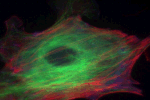Nanosurgery with femtosecond lasers
We have developed a technique to disrupt submicrometer-sized organelles within living cells or tissue without affecting the surrounding material or compromising viability of the cell or organism. When a femtosecond laser pulse is tightly focused into a nearly-transparent biological material, energy is deposited by nonlinear absorption only in the focus where laser intensity is high, resulting in disruption of the structure in the focal volume. Because the absorption is confined to the small focal volume, the surrounding material is unaffected, allowing micrometer precision in the disruption of biological tissue.
Subcellular surgery and nanosurgery,
at
Chemistry Seminar, Middle Tennessee University,
Friday, February 12, 2021
Subcellular surgery and nanosurgery,
at
Physics Colloquium, University of Massachusetts Boston (Boston, MA),
Wednesday, November 5, 2008:
Subcellular surgery and nanosurgery,
at
Wednesday Night Research Seminar, Harvard University (Cambridge, MA),
Wednesday, September 25, 2013:
Manipulation of Single Cells with Sub-cellular Precision Using Femtosecond Laser Pulses,
at
Photonics West, Commercial and Biomedical Applications of Ultrafast Lasers IV (San Jose, CA),
Wednesday, January 23, 2002:
Three-dimensional microfabrication for photonics and biomedical applications,
at
Macro 2006 - World Polymer Congress (Rio de Janeiro, RJ, Brazil),
Sunday, July 16, 2006:
Subcellular surgery and nanosurgery,
at
Physics Colloquium, University of Notre Dame (Notre Dame, IN),
Wednesday, May 12, 2010:
Laser-induced microexplosions: ultrafast physics with clinical applications,
at
20th Annual International Conference of the IEEE Engineering in Medicine and Biology Society (Hong Kong),
Thursday, October 29, 1998:
Subcellular surgery and nanoneurosurgery,
at
A Year of Physics Colloquium, North Carolina A&T State University (Greensboro, NC),
Thursday, November 10, 2005:
Subcellular surgery and nanosurgery,
at
Physics Colloquium, Amherst College (Amherst, MA),
Thursday, October 4, 2007:
Subcellular surgery and nanosurgery,
at
Physics Colloquium, Australian National University (Canberra, Australia),
Tuesday, March 24, 2009:
Plasmonic cell transfection using micropyramids,
at
SPIE Photonics West 2014 (San Francisco, CA),
Sunday, February 2, 2014:
Sub-cellular nanosurgery in live cells using ultrashort laser pulses,
at
Photonics West (San Jose, CA),
Friday, January 21, 2005:
Using short bursts of photons to manipulate biological matter at the nanoscale,
at
Winter Colloquium on the Physics of Quantum Electronics (Snowbird, UT),
Friday, January 5, 2007:
Determining properties of spindle microtubules with femtosecond nanosurgery,
at
BiOS 7897, SPIE Photonics West (San Francisco, CA),
Monday, January 24, 2011
 The detailed architecture of spindle microtubules, involved in cell division, was revealed using femtosecond laser nanosurgery. This work was performed in collaboration with the Needleman group (results published in Cell).
The detailed architecture of spindle microtubules, involved in cell division, was revealed using femtosecond laser nanosurgery. This work was performed in collaboration with the Needleman group (results published in Cell).